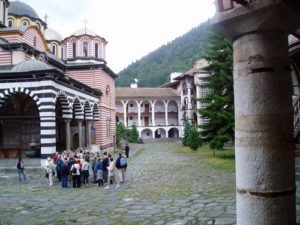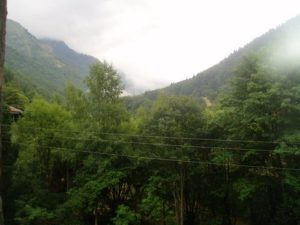We re-boarded our coach after an overnight stop in Sofia, the capital of Bulgaria. Our morning was to take us over 120 kms. due south towards the Greek boarder and up into the Rila Mountains and to the Rila Monastery. After negotiating the Sofia rush hour we eventually found ourselves on the main road south. If you drove to the very end you would be in Thessalonica, Greece. Although this was a main highway it was only one lane in each direction which at times made progress very difficult.
We passed through towns and villages before making our first coffee stop just outside the small town of Dupnitsa. It was here that we found a man selling honey from a cart. A sight we had not seen before. He had jars of all different sizes and was doing a very good trade with what appeared to be the local population. After a quick coffee we were on our way again.
Eventually we turned left off the main road onto a road that was devoid of traffic and ahead of us could be seen a range of mountains. This was the Rila range, our final destination. We passed through the village of Rila where the houses were decorated with hanging baskets and flowers of different colours in the gardens. Many of the gardens were used for growing vegetables and the majority had their own vines that were loaded with ripening grapes. These I later discovered would be harvested and used to make Raki a potent Bulgarian Brandy. At a later date I sampled some homemade Rakia and it tasted strong enough to take the enamel off of your teeth, but that is another story. After passing through the village the road began to narrow and buildings became sparser. The coach slowed to negotiate the bends. The scenery began to change as we started our long climb up the road to our final destination. Pine trees took over from houses and rivers took over from gardens. We were soon quite high up and the scenery was spectacular. All you could see were fir and pine trees amongst which brown bears and wild boar still freely roamed. A mist appeared to be rising from the trees as the damp from the previous night was burnt away by the late morning sun that was now high in the sky.
We stopped again for coffee and this time it was at a restaurant set amongst the trees. Behind the restaurant was a fast flowing river with the waters rushing towards the valley below. The temperature was in the mid 20c’s as we sat and drank our coffee in a setting that was so different from the coastal area we had left the previous day. 20 minutes later we were on our way again on the final leg of the journey.
It was about 30 minutes later when we slowed for a bend which on rounding it had us face to face with the outer walls of the Monastery of Saint Ivan of Rila, commonly known as the Rila Monastery. Founded in the 10th Century and built on its current site in the 14th Century it was breathe taking to look at the gold domes, the brickwork in red, white and black on a site surrounded by mountains and evergreens. We were now 4,181 feet above sea level.
We drove into the car park, left the coach and made our way through the stone arch entrance. Where do you start with a site such as this? The outer building forms a defensive square. In some ways it resembles a fortress with the church as the centre focal point. The outer building was used as the living quarters for the monks and contains 300 cells for monks, 4 chapels, and a room for the Abbot who was in charge as well as a kitchen on the ground floor and a library.
We went left and went into what was the original kitchen. The huge chimney above the cooking area rose skywards with a small hole at the top. It is difficult to imagine the monks cooking their meals there in a bygone age. We then visited the various parts of the building and in places could imagine the monks quietly going about their business in their hooded habits. To me the most beautiful part was the main church in the centre of the complex that was erected in the middle of the 19th century. It has five domes, three altars and two side chapels. The murals that adorn the walls both inside as well as the entrance porches have to be seen to be seen to be believed. The use of cameras and videos is forbidden inside the church although you can buy postcards that show its beauty.
You can still see bearded monks in their black robes walking silently about the grounds. When you visit you may be lucky enough to hear them sing which it is said they do several times a day. I was not lucky enough to witness this. In the museum is kept Rafails Cross. This is a famous cross made from a whole piece of wood. The story is it was whittled down by a monk named Rafail to recreate 104 religious scenes and 650 miniature figures. It is said that it took at least 12 years to complete before it was finished in 1802, when the monk lost his sight.
The monastery complex is looked upon as one of the greatest religious tourist attractions in Bulgaria and people come from all over the world to visit. In 1976 it was declared a national historical monument and in 1983 became a UNESCO World Heritage Site. On 25 May 2002 Pope Paul 2nd visited the Rila Monastery on his pilgrimage to Bulgaria. It is possible to stay in the monastery over night in some of the monks old cells that have been set up for guests. The cost when we visited was 10 Euro a night.
If you go to the Sofia area of Bulgaria this is a ‘Must See’. The setting is beautiful, quiet and tranquil. The green of the trees growing on the mountains sides set against the blue of the sky and the multi coloured bricks and domes of the monastery is a setting you will never forget. To miss it would be like a tourist coming to London and not seeing Buckingham Palace.









